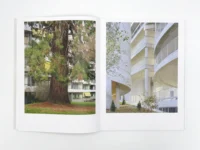
Analogue Images, Rory Gardiner, Maxime Delvaux
PHOTO Book Club – Rory Gardiner on Analogue Images
21.10.24
Originally conceived as an exhibition at the University of Sydney, Analogue Images presents the work of Australian photographer Rory Gardiner and Belgian photographer Maxime Delvaux side by side for the first time. Through the images of these two architectural photographers, alongside commissioned texts, the book questions the dialogues, tensions, and reciprocities between photography and the built environment. We spoke with Gardiner about his practice as an architectural photographer and the making of Analogue Images.
Hi Rory, how would you describe your practice to date?
I’ve always been frustrated with the impact of commerce on art, so the original intent when I decided to pursue architectural photography was to push towards amalgamating assignment work with self-initiated projects to the point where they became indistinguishable. When I first started working with architects though, things were more linear and transactional, largely due to my own technical anxieties and the trust I was building with the people I worked with. As I became more comfortable delivering assignments under the usual constraints of a commissioned shoot (short duration, variable weather, difficult project states, etc.) and my relationships with architects strengthened, I began to open up to more peripheral ways of looking at architecture. My practice gradually shifted towards actively disrupting the status quo of how architecture is represented in the media.
Currently, my focus is on the conversation about how market dynamics drive a ‘heroised’ iteration of architectural representation and the technology that has enabled the correlated consumption of imagery. Building my website into an archival component of my practice has been a useful step to allow me a broader overview the work, now acting a mechanism for closing each project, away from typical media outlets.
![Rory Gardiner Rory Gardiner, from [Analogue Images]. Courtesy the artist.](https://photo.org.au/api/wp-content/uploads/2024/10/Rory-Gardiner-200x160.jpeg)
Rory Gardiner, from Analogue Images. Courtesy the artist.
Can you tell us about Analogue Images, and how it reflects your approach to photographing architecture?
It was initially an exhibition in Sydney in 2023, showcasing the work of Belgian photographer Maxime Delvaux and myself. The curators (Guillermo Fernández-Abascal, Urtzi Grau, and Janelle Woo) were interested in representing a fragment of the relationship between contemporary architecture and how architectural photography has engaged with these movements over the last few years. Almost all of the work shown was from assignments and collaborations with architects. The book contains the original work and an additional set of images, accompanied by critical texts from people within the architectural community.
The selected work seemed to focus on our shared interest in peripheral, imperfect moments in architecture. Quieter and less aspirational images, often laced with the chaos of everyday life, were chosen as an antidote to the mainstream architectural media’s focus on heroic, more singular images. I felt that both the show and the book encouraged me that people are interested in this more challenging line of investigation as a way to further broaden the conversation about architectural representation.
What led you to collaborate with Maxime?
Part of the curators’ initial idea for the show was that Maxime and I would shoot something together and switch the editing and processing processes, meaning we would each select and post-produce each other’s images. The idea was a form of research about authorship, particularly as a means to discuss how much agency the photographer has in the way we consume images of buildings.
![Maxime Delvaux Maxime Delvaux, from [Analogue Images]. Courtesy the artist.](https://photo.org.au/api/wp-content/uploads/2024/10/Maxime-Delvaux-200x160.jpg)
Maxime Delvaux, from Analogue Images. Courtesy the artist.
Can you tell us about the process of translating Analogue Images from an exhibition into a book?
The curators worked with Perimeter Editions to build a more comprehensive exploration of the topic, doubling the number of images from the show. There was also further inclusion of both Maxime’s and my experimental collaborations with people in adjacent mediums, along with some of our self-initiated projects. Additionally, the critical texts allowed the architectural community to have a participatory (and rightfully critical) voice in making what is, in effect, a document of a temporally narrow moment in global architecture.
And finally, what advice would you give your 15-year-old self?
Stay in art school as long as possible! You might never again get this sort of time to freely develop your practice, surrounded by so many people with a similar focus.